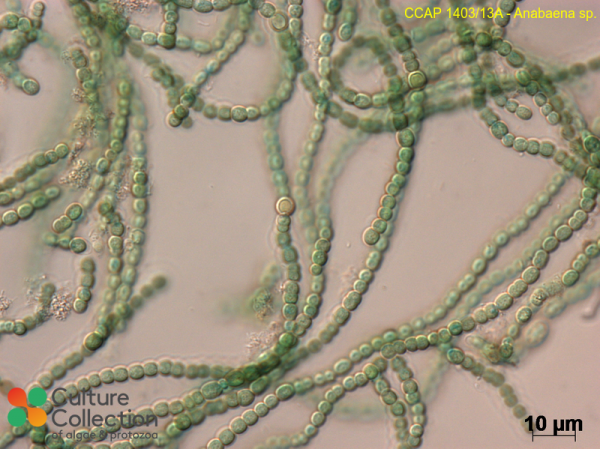References [ 19 ]
Jensen BB & Cox RP (1983) Direct measurements of steady-state kinetics of cyanobacterial N2 uptake by membrane-leak mass spectrometry and comparisons between nitrogen fixation and acetylene reduction. Applied and Environmental Microbiology 45(4): 1331-1337.
DOI: none
Gachon CMM, Day JG, Campbell CN, Pröschold T, Saxon RJ & Küpper FC (2007) The Culture Collection of Algae and Protozoa (CCAP): A biological resource for protistan genomics Gene 406: 51-57.
Smith JK, Parry JD, Day JG & Smith RJ (1998) A PCR technique based on HIP1 interspersed repetitive sequence distinguishes cyanobacterial species and strains. Microbiology 144: 2791-2801.
Stulp BK, Bos SA, Stenveld H & Stam WT (1984) Growth of Anabaena strains (Cyanophyceae) exposed to crossed gradients of light and temperature. Cryptogamie Algologie 5: 63-71.
DOI: none
Wang AW & Tischer RG (1974) Preservation of the sheath of a blue-green alga, Anabaena flos-aquae A-37. Canadian Journal of Microbiology 20(10): 1415-1416.
Stulp BK & Stam WT (1984) Genotypic relationships between strains of Anabaena (Cyanophyceae) and their correlation with morphological affinities. British Phycological Journal 19(3): 287-301.
Stulp BK & Stam WT (1984) Growth and morphology of Anabaena strains (Cyanophyceae, Cyanobacteria) in cultures under different salinities. British Phycological Journal 19(3): 281-286.
Hashemi F, Leppard GG & Kushner DJ (1994) Copper resistance in Anabaena variabilis: Effects of phosphate nutrition and polyphosphate bodies. Microbial Ecology 27: 159-176.
DOI: none
Wright SJL, Redhead K & Maudsley H (1981) Acanthamoeba castellanii, a predator of cyanobacteria. Journal of General Microbiology 125: 293-300.
Jensen BB (1983) Energy requirement for diazotrophic growth of the cyanobacterium Anabaena variabilis determined from growth yields in the dark. Journal of General Microbiology 129: 2633-2640.
Kolar B, Arnus L, Jeretin B, Gutmaher A, Drobne D & Durjava MK (2014) The toxic effect of oxytetracycline and trimethoprim in the aquatic environment. Chemosphere 115: 75-80.
Bharathiraja B, Chakravarthy M, Ranjith Kumar R, Yogendran D, Yuvaraj D, Jayamuthunagai J, Praveen Kumar R & Palani S (2015) Aquatic biomass (algae) as a future feed stock for bio-refineries: A review on cultivation, processing and products. Renewable and Sustainable Energy Reviews 47: 634-653.
Tsygankov AS, Serebryakova LT, Sveshnikov DA, Rao KK, Gogotov IN & Hall DO (1997) Hydrogen photoproduction by three different nitrogenases in whole cells of Anabaena variabilis and the dependence on pH. International Journal of Hydrogen Energy 22: 859-867.
Yoon JH, Shin JH, Kim MS, Sim SJ & Park TH (2006) Evaluation of conversion efficiency of light to hydrogen energy by Anabaena variabilis. International Journal of Hydrogen Energy 31: 721-727.
Zehr JP, Mellon MT & Hiorns WD (1997) Phylogeny of cyanobacterial nifH genes: evolutionary implications and potential applications to natural assemblages. Microbiology 143: 1443-1450.
Guo J, Selby K & Boxall A (2016) Comparing the sensitivity of chlorophytes, cyanobacteria and diatoms to major-use antibiotics. Environmental Toxicology and Chemistry 35: 2587-2596.
Chen X, Schreiber K, Appel J, Makowka A, Fähnrich B, Roettger M, Hajirezaei MR, Sönnichsen FD, Schönheit P, Martin WF & Gutekunst K (2016) The Entner-Doudoroff pathway is an overlooked glycolytic route in cyanobacteria and plants. PNAS 113: 5441-5446.
Le Page G, Gunnarsson L, Trznadel M, Wedgewood KCA, Baudrot V, Snape J & Tyler CR (2019) Variability in cyanobacteria sensitivity to antibiotics and implications for environmental risk assessment Science of the Total Environment 695: 133804.
Le Page G, Gunnarsson L, Snape J & Tyler CR (2019) Development and Application of a Microplate Assay for Toxicity Testing on Aquatic Cyanobacteria Environmental Toxicology and Chemistry 39: 705-720.


